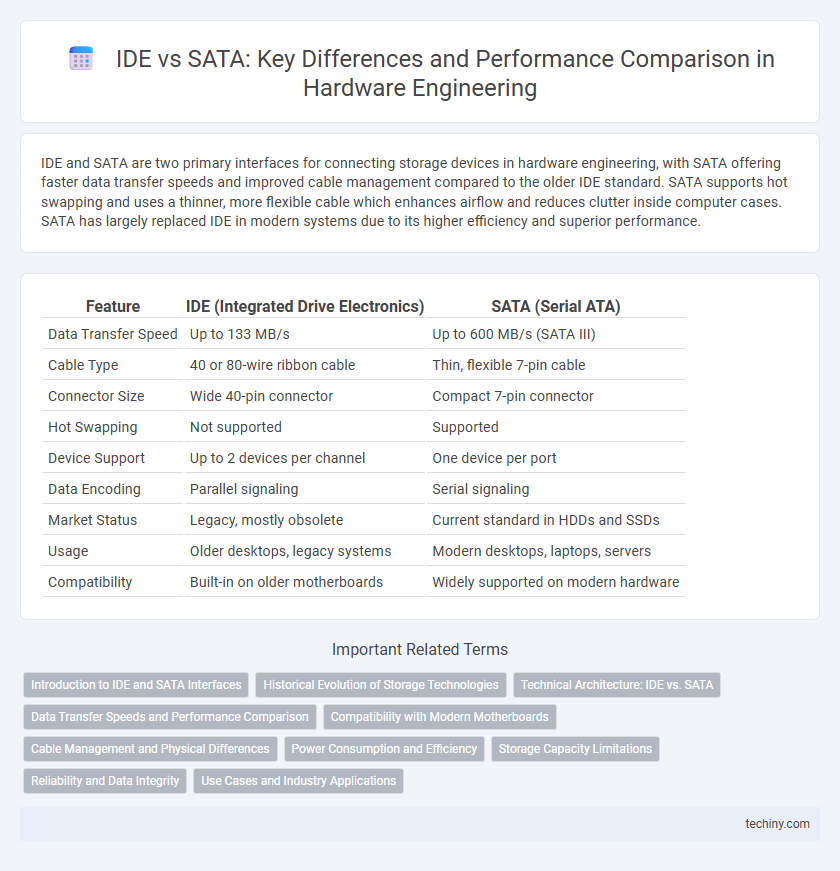IDE and SATA are two primary interfaces for connecting storage devices in hardware engineering, with SATA offering faster data transfer speeds and improved cable management compared to the older IDE standard. SATA supports hot swapping and uses a thinner, more flexible cable which enhances airflow and reduces clutter inside computer cases. SATA has largely replaced IDE in modern systems due to its higher efficiency and superior performance.
Table of Comparison
| Feature | IDE (Integrated Drive Electronics) | SATA (Serial ATA) |
|---|---|---|
| Data Transfer Speed | Up to 133 MB/s | Up to 600 MB/s (SATA III) |
| Cable Type | 40 or 80-wire ribbon cable | Thin, flexible 7-pin cable |
| Connector Size | Wide 40-pin connector | Compact 7-pin connector |
| Hot Swapping | Not supported | Supported |
| Device Support | Up to 2 devices per channel | One device per port |
| Data Encoding | Parallel signaling | Serial signaling |
| Market Status | Legacy, mostly obsolete | Current standard in HDDs and SSDs |
| Usage | Older desktops, legacy systems | Modern desktops, laptops, servers |
| Compatibility | Built-in on older motherboards | Widely supported on modern hardware |
Introduction to IDE and SATA Interfaces
Integrated Drive Electronics (IDE) and Serial Advanced Technology Attachment (SATA) are two prominent interfaces for connecting storage devices to a computer's motherboard. IDE, also known as Parallel ATA (PATA), utilizes a 40- or 80-wire ribbon cable and supports data transfer rates up to 133 MB/s, traditionally used in older hardware systems. SATA offers faster data transfer speeds starting at 150 MB/s with thinner, more flexible cables that improve airflow and ease of installation, making it the standard interface for modern hard drives and solid-state drives.
Historical Evolution of Storage Technologies
The historical evolution of storage technologies highlights the transition from IDE (Integrated Drive Electronics) to SATA (Serial ATA) interfaces, where IDE dominated in the 1980s and 1990s with parallel data transfer limitations and slower speeds up to 133 MB/s. SATA emerged in the early 2000s, introducing serial communication, faster transfer rates starting at 150 MB/s, and improved cable management, significantly enhancing data throughput and system efficiency. This shift reflected the industry's growing demand for higher performance, scalability, and compatibility with evolving hard drive technologies and operating systems.
Technical Architecture: IDE vs. SATA
IDE (Integrated Drive Electronics) uses a parallel communication interface with a 40-pin connector, supporting data transfer rates up to 133 MB/s through its ATA standard. SATA (Serial ATA) employs a serial communication protocol with a 7-pin connector, significantly improving data transfer speeds ranging from 150 MB/s (SATA I) to 600 MB/s (SATA III) and reducing cable complexity. SATA's point-to-point architecture enhances signal integrity and allows hot-swapping, whereas IDE's shared bus design limits scalability and increases signal interference.
Data Transfer Speeds and Performance Comparison
SATA interfaces offer significantly faster data transfer speeds compared to IDE, with SATA III supporting up to 6 Gbps, while IDE maxes out at 133 Mbps. SATA's improved performance reduces latency and increases throughput, making it ideal for modern storage devices and high-performance applications. IDE, being an older technology, is largely obsolete for contemporary hardware engineering projects requiring efficient data transfer.
Compatibility with Modern Motherboards
SATA interfaces are widely supported by modern motherboards, offering faster data transfer rates up to 6 Gbps and hot-swapping capabilities, which IDE lacks. IDE connections, mostly found in older systems, are generally incompatible with contemporary motherboards without specialized adapters or controllers. Modern hardware engineering favors SATA for its improved performance, compatibility, and streamlined integration with current system architectures.
Cable Management and Physical Differences
IDE cables are wide and flat, typically with 40 or 80 wires, which can obstruct airflow and complicate cable management inside computer cases. SATA cables are much thinner and more flexible, allowing easier routing and improved airflow, reducing overall system temperatures. Physically, IDE connectors are larger with a 40-pin interface, while SATA uses a slim 7-pin connector, enhancing space efficiency on motherboards and storage devices.
Power Consumption and Efficiency
SATA drives typically consume less power than IDE drives due to their advanced design and more efficient data transfer protocols. SATA interfaces support lower voltage operation, reducing overall energy consumption during both active use and idle states. Optimizing hardware with SATA technology improves system power efficiency, contributing to longer lifespan and reduced thermal output in hardware engineering applications.
Storage Capacity Limitations
IDE (Integrated Drive Electronics) interfaces typically support storage devices with capacities up to 2 TB due to the 28-bit addressing limitation inherent in the ATA standard. SATA (Serial ATA) technology overcomes this limitation by utilizing 48-bit addressing, enabling support for modern drives exceeding 16 exabytes theoretically, with current hardware commonly supporting multi-terabyte capacities. These advancements in SATA have driven significant improvements in storage scalability and performance compared to the older IDE systems.
Reliability and Data Integrity
SATA interfaces generally offer higher reliability and better data integrity compared to IDE due to improved error checking and correction protocols, such as Native Command Queuing (NCQ) and CRC error detection. IDE drives are more prone to signal degradation and data corruption because of their parallel data transmission and older technology standards. Modern hardware engineering favors SATA for critical applications requiring consistent performance and minimal data loss over time.
Use Cases and Industry Applications
IDE interfaces remain prevalent in legacy systems for industrial automation and embedded applications where compatibility with older hardware is critical. SATA dominates in modern computing environments, including data centers and consumer electronics, due to its higher data transfer speeds and improved support for SSDs. Automotive and aerospace industries utilize SATA-based storage solutions to meet stringent performance and reliability standards in real-time data processing.
IDE vs SATA Infographic

 techiny.com
techiny.com